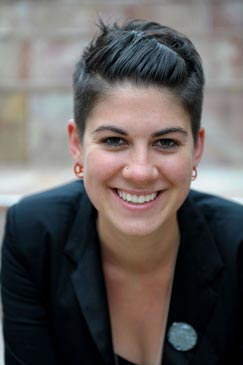Life Cycle Assessment is a cornerstone of any sustainable design project. Here is a brief introduction into the heady world of choosing the right material, for the right application, for the smallest environmental impact.

Leyla Acaroglu, director of Australian-based Life Cycle Assessment and eco-design consultancy, Eco Innovators.
As an adviser into sustainable design and production in product development, I always get asked the same question from designers wanting to create ‘greener’ products – ‘what’s the most environmentally friendly material?’
Green material selection has become somewhat of the holy grail of sustainable design – always talked about, but never really ever found – and from a life cycle assessment (LCA) perspective the answer to ‘what material should I use’ is always ‘it depends’.
Actually ‘it depends’ is the most commonly used response by an LCA practitioner and it’s not because they want to be annoying; it’s because it really does depend on a number of key considerations. Such as, what is the expected life of the product, how will it be used, what are the material parameters that the material should be able to withstand, is there an active recycling and recapture market for the material in the country the product will be used in, how long is the product likely to be used (no point using high value materials in a disposable product)? The list goes on.
Whilst this might seem a little overwhelming and a somewhat impossible task to get your head around (I can hear all the – ‘but how on earth I am going to know what the sustainable material is even if I answer all these questions?’). Rest assured there is help in navigating the path towards sustainable product design. Taking a life cycle approach is one of the most effective ways of gaining a clearer understating of all the pros and cons that a material or process has. It’s important to initially accept that there are really no truly sustainable materials because everything (and I mean everything) has to be extracted from nature at some stage. And, even if we moved to fully biodegradable alternatives for everything then we would quickly find ourselves in other problematic situations such as global food shortages.
Information is king
Information is king in the eco world. The more we know about what has to happen in order to get what we need – the better position we are in to make informed environmentally preferable choices. So many products are designed to just meet the ‘3 pillars’ of design – aesthetics, functionality and marketability – but too few are created with a real understanding of the social and environmental consequences. It’s about time we fix this three-legged approach and add a fourth pillar of good old fashion responsibility.
So getting back to the LCA part of this. Life Cycle Assessment (or analysis as it’s sometimes called) is a scientific process of evaluating the whole of life environmental impacts of a product, system or service. It is governed by ISO 14040 which sets out the guidelines for best practice LCA. They are conducted in four main stages:
Goal and scope – define what you are looking at and what you will not assess by doing a map of the product system and popping a boundary around it. Define the functional unit and, if doing a comparison, make sure that the functional unit is equal between the two systems. So for example if you were designing a kettle, you might define the functional unit as boiling two litres of water.
Inventory analysis – you define all the parts of your system and collect the data for each part, and this is usually done through accessing databases – but if you are using streamlined LCA tools such as Sustainable Minds then you will be selecting data from the tool.
Impact assessment – based on the collected data, assess the potential environmental impacts. This can be done on the back of an envelope, in a high end tool such as SimaPro or through a streamlined tool. The objective is to find out where the big impacts are occurring and in what way so that decisions can be made to reduce these.
Interpretation – now you have an assessment you need to interpret what it all means and this can be a lot harder than you might think. You really do need a good understating of key environmental impact areas to get the most out of LCA results – this is why getting a professional to help out really does make it much easier.
LCA looks at all the main life cycle stages that a product goes through, these are: material extraction, manufacturing, transport and packaging, use and of course everyone’s favorite – end of life. At each of these stages your product interacts with the environment, taking resources (inputs) and generating waste (outputs). LCA looks at the effects that these inputs and outputs have on the environment across a variety of impact categories such as global warming, water use, acidification, toxicity and solid waste generation.
For example, your laptop has aluminum in it. This has to be extracted from the environment, manufactured into aluminum, transported, packaged and then manufactured again into the component that sits inside your laptop so you can use it. At some point you will get a new laptop and the old one will have to find an end of life option. The aluminum could end up in landfill along with the rest of the laptop or it could be extracted and re-used (this could be through manual disassembly or through shredding techniques).
Now imagine all of these life cycle stages and all of the things that go into making that happen. Machines that dig metals out of the ground, fuel that powers the machines, metal that was previously mined in order to build the machines. At some point you have to stop and put a system boundary around your product’s life cycle map – but when you start to actually think about everything that has to happen to get you a computer – you can quickly start to see the complexity and possibilities for change.
Functionality
LCA is really based on the comparison of alternative ways of providing a defined service. All products deliver a service and therefore it’s really fundamental that we define the functionality and the delivery of service first. This is also really a fundamental part of sustainable design, defining what you are trying to provide the end user in terms of service and functionality allows real innovation and creativity. So, don’t define your product as a kettle, define it as the delivery of boiled water. At the end of the day, someone will purchase your product because they need the service you are offering, eco-design is all about providing the service with the least environmental burden.
LCA is a powerful tool for gaining insight into the environmental performance of a product or design decision, however it’s not for everyone and is only really as good as the person conducting it. So one of the best places to start is with life cycle thinking (LCT) which is essentially a framework for sustainable decision making that draws on the learnings of LCA.
Life Cycle Thinking
Life Cycle Thinking is about taking a holistic approach, not just looking at one area or focusing on one thing (such as material substitution or end of life options). By exploring all of the life cycle stages that something goes through, and mapping these out, it’s much easier to identify areas for improvement and consider design solutions that go beyond just re-design.
This involves starting with a clear understanding of what life cycle stages are and what general impacts occur at each stage. A simple exercise involves mapping the life cycle of a product across its life cycle stages and looking at the different inputs and outputs that occur at each life cycle stage. This visualisation input and outputs assists in mapping the potential impacts of the product. Another good starting point is using tools such as Sustainable Minds that allows for quick LCAs. Basically there is enough aggregated data included so that you can assess design iterations to find environmentally beneficial outcomes.
LCA and product eco-design is like anything else, it takes time to perfect but if you try it enough times you just naturally get good at it. So I recommend giving it a go.
Leyla Acaroglu is director of Australian-based Life Cycle Assessment and eco-design consultancy, Eco Innovators. She has developed award winning sustainability education projects, as well as having launched many successful communication and engagement projects around design for sustainability. Leyla can be reached at www.ecoinnovators.com.au or @ecoinnovators on twitter.
Choosing the right material, for the right application, for the smallest environmental impact
No







